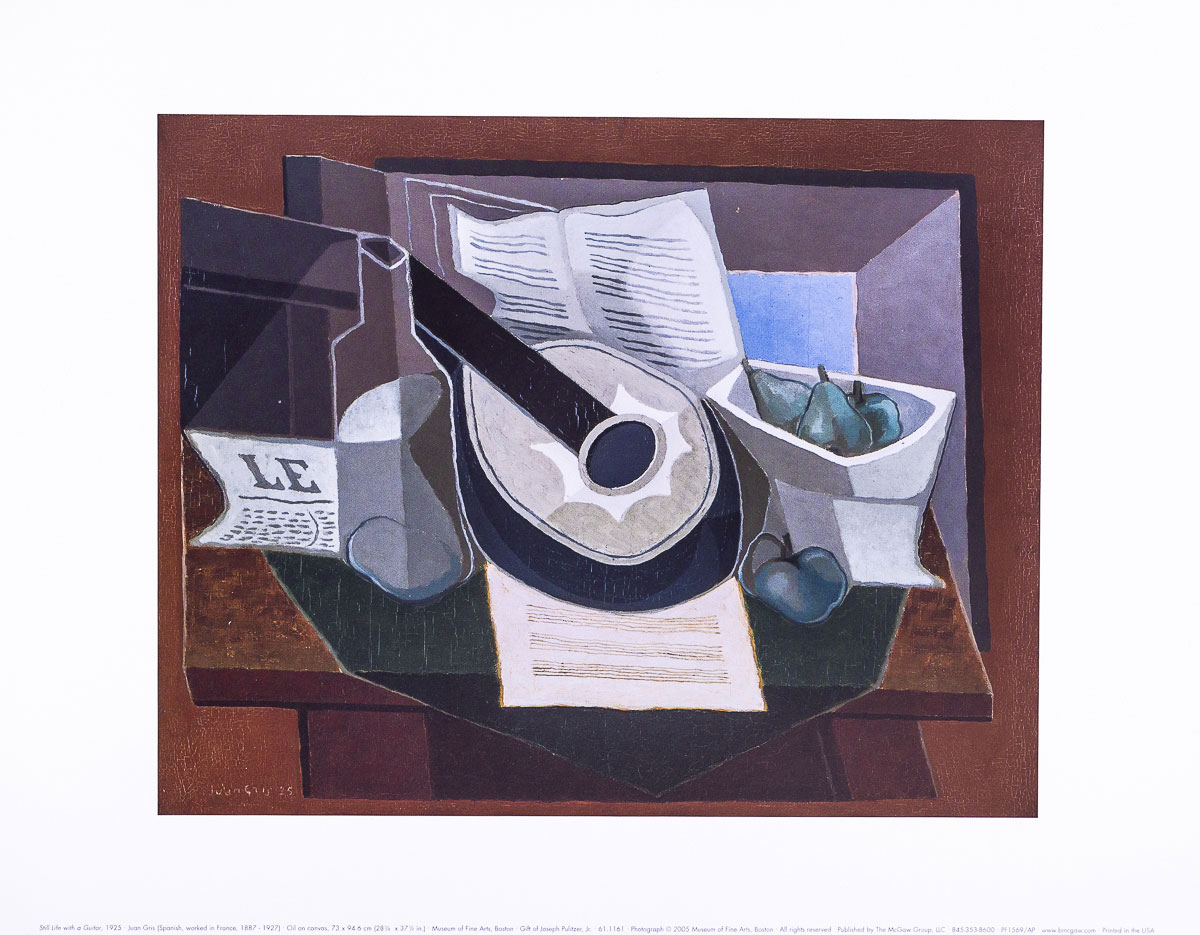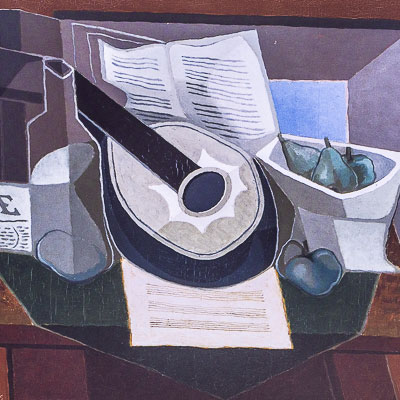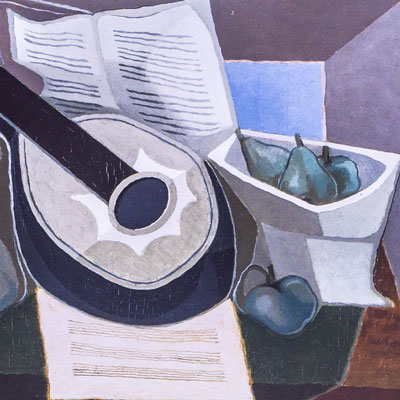Tel : (+33) 4 94 63 18 08
9am - 6pm from Monday to Sunday
All products Juan Gris • Products of the topic Abstract
Juan Gris Art Print - Still life with a guitar
REF : JGR-OFF-01
In stock
Only 1 in stock
Unavailable
15,00 €
(16.6 USD)
Juan Gris Art print : "Still life with a guitar (1925)"
This print is based on the original oil on canvas measuring 94.6 x 73 cm (Museum of Fine Arts, Boston).
Support : Thick, satin Fine Art paper
Dimensions : 36 x 28 cm
Cubism
The cubist movement in painting was one of the most important and influential artistic movements of the 20th century. It was developed by Pablo Picasso and Georges Braque from 1907, and expanded to include other artists such as Juan Gris and Francis Picabia. Cubism is characterized by the fragmentation of forms and the use of geometric lines and planes to represent objects in an abstract manner. Cubist artists also used a limited color palette and often incorporated African-inspired patterns and cubic forms in their works. Cubism had a significant impact on modern art and influenced many later movements, such as futurism and lyrical abstraction. It also had an influence on other areas of culture, such as architecture and fashion.
Discover the artist
Gris Juan
Juan Gris was a Spanish artist born on March 23, 1887 in Madrid and died on May 11, 1927 in Boulogne-sur-Seine, France. He is considered one of the main representatives of the Cubist movement. He studied mechanical engineering in Madrid before moving to Paris in 1906, where he began working as a draftsman for magazines. He quickly began frequenting artistic circles in Montparnasse and becoming familiar with the artistic avant-gardes of the time. In 1910, Juan Gris met Pablo Picasso, who would become his friend and mentor. Picasso played an important role in Gris's artistic development, encouraging him to move away from realistic styles and explore the possibilities of color and form. He thus began producing Cubist works from 1911, working closely with Picasso and Georges Braque. His style is characterized by the use of simple geometric shapes, bright colors, and varied textures. He was also known for his use of the collage technique, incorporating elements of daily life into his works. He died prematurely at the age of 40 on May 11, 1927 from kidney failure. Despite his short career, he left a lasting and influential artistic legacy. His works are presented notably at the Musée national d'art moderne in Paris, the Reina Sofia Museum in Madrid, and the Museum of Modern Art in New York.
Gris Juan
Juan Gris was a Spanish artist born on March 23, 1887 in Madrid and died on May 11, 1927 in Boulogne-sur-Seine, France. He is considered one of the main representatives of the Cubist movement. He studied mechanical engineering in Madrid before moving to Paris in 1906, where he began working as a draftsman for magazines. He quickly began frequenting artistic circles in Montparnasse and becoming familiar with the artistic avant-gardes of the time. In 1910, Juan Gris met Pablo Picasso, who would become his friend and mentor. Picasso played an important role in Gris's artistic development, encouraging him to move away from realistic styles and explore the possibilities of color and form. He thus began producing Cubist works from 1911, working closely with Picasso and Georges Braque. His style is characterized by the use of simple geometric shapes, bright colors, and varied textures. He was also known for his use of the collage technique, incorporating elements of daily life into his works. He died prematurely at the age of 40 on May 11, 1927 from kidney failure. Despite his short career, he left a lasting and influential artistic legacy. His works are presented notably at the Musée national d'art moderne in Paris, the Reina Sofia Museum in Madrid, and the Museum of Modern Art in New York.
Gris Juan
Juan Gris was a Spanish artist born on March 23, 1887 in Madrid and died on May 11, 1927 in Boulogne-sur-Seine, France. He is considered one of the main representatives of the Cubist movement. He studied mechanical engineering in Madrid before moving to Paris in 1906, where he began working as a draftsman for magazines. He quickly began frequenting artistic circles in Montparnasse and becoming familiar with the artistic avant-gardes of the time. In 1910, Juan Gris met Pablo Picasso, who would become his friend and mentor. Picasso played an important role in Gris's artistic development, encouraging him to move away from realistic styles and explore the possibilities of color and form. He thus began producing Cubist works from 1911, working closely with Picasso and Georges Braque. His style is characterized by the use of simple geometric shapes, bright colors, and varied textures. He was also known for his use of the collage technique, incorporating elements of daily life into his works. He died prematurely at the age of 40 on May 11, 1927 from kidney failure. Despite his short career, he left a lasting and influential artistic legacy. His works are presented notably at the Musée national d'art moderne in Paris, the Reina Sofia Museum in Madrid, and the Museum of Modern Art in New York.
Gris Juan
Juan Gris was a Spanish artist born on March 23, 1887 in Madrid and died on May 11, 1927 in Boulogne-sur-Seine, France. He is considered one of the main representatives of the Cubist movement. He studied mechanical engineering in Madrid before moving to Paris in 1906, where he began working as a draftsman for magazines. He quickly began frequenting artistic circles in Montparnasse and becoming familiar with the artistic avant-gardes of the time. In 1910, Juan Gris met Pablo Picasso, who would become his friend and mentor. Picasso played an important role in Gris's artistic development, encouraging him to move away from realistic styles and explore the possibilities of color and form. He thus began producing Cubist works from 1911, working closely with Picasso and Georges Braque. His style is characterized by the use of simple geometric shapes, bright colors, and varied textures. He was also known for his use of the collage technique, incorporating elements of daily life into his works. He died prematurely at the age of 40 on May 11, 1927 from kidney failure. Despite his short career, he left a lasting and influential artistic legacy. His works are presented notably at the Musée national d'art moderne in Paris, the Reina Sofia Museum in Madrid, and the Museum of Modern Art in New York.
Gris Juan
Juan Gris was a Spanish artist born on March 23, 1887 in Madrid and died on May 11, 1927 in Boulogne-sur-Seine, France. He is considered one of the main representatives of the Cubist movement. He studied mechanical engineering in Madrid before moving to Paris in 1906, where he began working as a draftsman for magazines. He quickly began frequenting artistic circles in Montparnasse and becoming familiar with the artistic avant-gardes of the time. In 1910, Juan Gris met Pablo Picasso, who would become his friend and mentor. Picasso played an important role in Gris's artistic development, encouraging him to move away from realistic styles and explore the possibilities of color and form. He thus began producing Cubist works from 1911, working closely with Picasso and Georges Braque. His style is characterized by the use of simple geometric shapes, bright colors, and varied textures. He was also known for his use of the collage technique, incorporating elements of daily life into his works. He died prematurely at the age of 40 on May 11, 1927 from kidney failure. Despite his short career, he left a lasting and influential artistic legacy. His works are presented notably at the Musée national d'art moderne in Paris, the Reina Sofia Museum in Madrid, and the Museum of Modern Art in New York.































































































